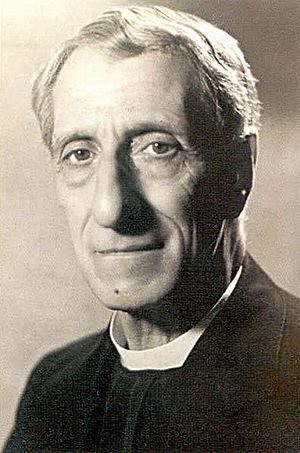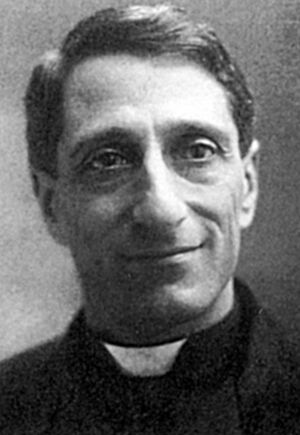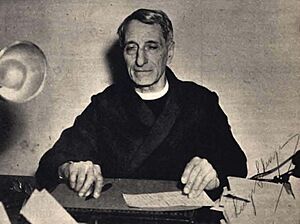Luigi Sturzo facts for kids
Quick facts for kids
Senator for life
Father Luigi Sturzo
|
|
|---|---|

Undated photograph.
|
|
| Senator for Life | |
| In office 17 September 1952 – 8 August 1959 |
|
| Appointed by | Luigi Einaudi |
| Vice-Mayor of Caltagirone | |
| In office 1905–1920 |
|
| Personal details | |
| Born | 26 November 1871 Caltagirone, Sicily, Kingdom of Italy |
| Died | 8 August 1959 (aged 87) Rome, Lazio, Italy |
| Political party | Italian People's Party (1919–24) Independent (1924–43) |
| Residences | Rome, Italy |
| Alma mater | Pontifical Gregorian University |
| Profession | Politician Priest |
Luigi Sturzo (26 November 1871 – 8 August 1959) was an Italian Catholic priest and an important politician. He was known as a "clerical socialist," meaning he believed in social justice and helping others, guided by Christian values. He is seen as one of the main thinkers behind the Christian democratic idea, which combines Christian beliefs with democratic politics.
Sturzo also started the Luigi Sturzo Institute in 1951, which is a place for research. In 1919, he helped create the Italian People's Party. However, he was forced to leave Italy in 1924 when Italian fascism became powerful. He lived in London and later New York, where he wrote many articles criticizing fascism. After his death, these articles were collected in a book called Miscellanea Londinese.
Today, there is a process to make him a saint in the Catholic Church. This process began on 23 March 2002, and he is currently called a Servant of God.
Contents
Life Story
Early Life and Priesthood
Luigi Sturzo was born on 26 November 1871 in Caltagirone, a town in Sicily, Italy. His parents were Felice Sturzo and Caterina Boscarelli. He had a twin sister named Emanuela. His older brother, Mario, became a well-known bishop and theologian.
From 1883 to 1886, Luigi studied in different towns in Sicily. In 1888, he began his studies to become a priest. He became a priest on 19 May 1894. After that, he taught philosophy and theology in his hometown. He also served as the Vice-Mayor of Caltagirone from 1905 to 1920. In 1898, he earned a special degree in philosophy from the Pontifical Gregorian University in Rome.
In his free time, Sturzo enjoyed collecting old ceramic art. As Vice-Mayor, he even opened a school for ceramic artists in 1918. He also started a newspaper called La Croce di Constantino in 1897. In 1900, he wanted to become a missionary in China, but his bishop said no because of his health. Sturzo was also involved with a Catholic group called Azione Cattolica since 1915.
Founding the Italian People's Party
Luigi Sturzo was one of the key people who started the Partito Popolare Italiano (PPI) on 19 January 1919. This was a big moment because, for a long time, the Vatican (the center of the Catholic Church) had told Catholics not to be involved in Italian politics. But with the PPI, this rule changed.
The PPI quickly became a very strong political group in Italy. Between 1919 and 1922, no government could be formed without the PPI's support. Sturzo was strongly against Benito Mussolini and his Fascist movement. He wrote about why Catholicism and Fascism could not work together.
Sturzo refused to support a law called the Acerbo Law in July 1923, which would have given more power to Mussolini's party. Because he opposed Mussolini, Sturzo was forced to step down as the leader of the PPI on 10 July 1923. The Vatican also pressured him to leave politics. After this, the Vatican supported a pro-Fascist group, which weakened the PPI. Eventually, Sturzo was forced to leave Italy before Mussolini's power grew even stronger.
Life in Exile
Sturzo lived outside of Italy from 1924 to 1946. He first went to London in 1924 and stayed there until 1940. Then, he moved to the United States of America and lived there until 1946. When he first arrived in London, he was quite alone because he didn't speak English well. He was also pressured by the Vatican to stop his political writing and activism.
However, Sturzo refused to give up his work. He continued to write articles and speak out against fascism. During World War II, he even worked with British and American intelligence groups. He shared his thoughts on the political situation in Italy and made radio broadcasts to his home country. He wanted to return to Italy sooner, but his return was delayed by political reasons.
Return to Italy and Later Years
Sturzo finally returned to Italy on 6 September 1946. After his return, he did not play a major role in everyday Italian politics. Instead, he focused on other important work. In 1951, he started the Luigi Sturzo Institute. This institute was created to support research in history, economics, and politics.
In 1953, he was made a Senator for life by the President of Italy, Luigi Einaudi. This was a special honor. Luigi Sturzo passed away in Rome on 8 August 1959. His body was first buried in Rome, but later moved to the church of Santissimo Salvatore in his hometown of Caltagirone in 1962.
Path to Sainthood
The process to recognize Luigi Sturzo as a saint in the Catholic Church began on 23 March 2002. At this time, he was given the title Servant of God. This means the Church has officially started looking into his life to see if he lived a holy life.
A special investigation process began on 3 May 2002, looking into his life and writings. This part of the process finished on 24 November 2017. Recent reports suggest that the cause for his beatification is moving forward. If the process continues successfully, he could soon be named Venerable, which is another step toward sainthood.
See also
 In Spanish: Luigi Sturzo para niños
In Spanish: Luigi Sturzo para niños
- Luigi Sturzo Institute
Books by Luigi Sturzo
Luigi Sturzo wrote several important books about philosophy and political ideas. Some of his works include:
- Church and State (1939)
- The True Life (1943)
- The Inner Laws of Society (1944)
- Spiritual Problems of Our Times (1945)
- Italy and the Coming World (1945)



